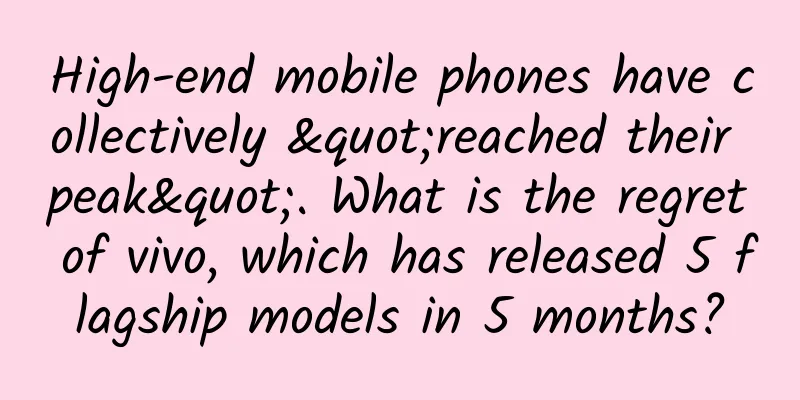High-end mobile phones have collectively "reached their peak". What is the regret of vivo, which has released 5 flagship models in 5 months?

|
Perhaps due to the "crazy" price-performance competition among domestic mobile phone brands, the "ceiling" of the high-end smartphone industry has come earlier than we expected. Especially in 2016, high-definition screens, metal bodies, fingerprint recognition and other features that were originally able to distinguish product positioning have almost become standard features of all mobile phones. The difference between "hot" or "not hot" processing has become difficult to feel in daily use, so much so that when the 799 yuan Meizu Note3 was released, the necessity of the existence of high-end smartphones has become highly controversial. But there are always people who go against the trend. On April 14, vivo officially released the new X6S/X6S Plus product series, with starting prices of 2598 and 2998 yuan. Not many people would believe that these are not high-end flagships. However, less than two months ago, the vivo Xplay5 priced at 4000 yuan was just released, and the previous generation products of X6S/X6S Plus, X6 and X6 Plus, were released at the end of November last year and it has been less than five months. Even Apple, the absolute leader in the industry, only updates its mobile phones twice a year at most. In contrast, Vivo has released five consecutive flagship new products in less than five months, including different models and sizes. This speed really shows that it has greater courage than Apple. Or, does this courage really have the confidence? Curved screen & large memory, good topics are hard to find substantial upgrades From Xplay5 to X6S, the main upgraded elements of vivo's products this year are concentrated on curved screen and ultra-large memory. These two upgraded points can certainly be seen as vivo's own solutions in the environment where high-end mobile phones have "reached the top". First of all, the curved screen undoubtedly makes the phone look cooler and more marketable. You can even say that it is the curved screen that has made it possible for Samsung to "turn things around" after launching the Galaxy S6/S7. But the actual significance of curved screens on mobile phones ultimately seems to be similar to the "three-minute novelty" of 3D Touch on the iPhone. Samsung's functional expansion of curved screens on edge-label products is extremely limited. Vivo, which directly uses Samsung parts to "install" the machine, naturally cannot expect too much. However, the easy scratching nature of curved screens and the high maintenance cost apply to all products. High-end phones with curved screens are more expensive if they fall. In addition, for the vivo X6S and X6S Plus, which do not have a curved screen design, the only thing they can show off is perhaps the large memory. Vivo has directly increased the RAM capacity of Android phones to an exaggerated 6GB on the Xplay5 flagship version. Other products this year also start with a minimum of 4GB RAM. Judging from the data alone, it is several times more than the iPhone 6s. The ROM capacity of several products is no less than 64 GB. There is no doubt that the larger the mobile phone memory, the better. However, looking at the mobile phone industry, if a domestic mobile phone with a large memory priced at more than 2,500 yuan is equipped with a mid-range Qualcomm Snapdragon 652 processor, it makes people feel that the "premium" component of memory capacity is a bit heavy. After all, even if the mobile phone is given 8GB RAM, it can't run "GTA5" and "Call of Duty 12". As for the ultra-large 64GB ROM, for ordinary consumers to watch TV series and copy movies, it is not as cost-effective as opening external expansion cards to increase capacity like Samsung S7 and Sony Z5. It is a pity that domestic high-end mobile phones are only "high-end" in terms of price. Whether it was the world's first 2K resolution screen launched by Xplay3S more than two years ago, or the previous efforts in Hi-Fi, ultra-thin design and photography, the "international style" of vivo not only symbolizes the high-end of domestic mobile phones, but is also a brand worthy of respect among geeks. Unfortunately, this feeling has become increasingly distorted over the years. According to the comparison of parameters, apart from the processor upgrade which is not surprising, the vivo X6S and X6S Plus are exactly the same products as the X6/X6 Plus 5 months ago. The higher-end Xplay5 series has few highlights except for the "external part" curved screen. This less-than-extreme flagship strategy is completely different from the previous brand style. On the other hand, vivo's consistent high-priced image has not changed. Xiaomi takes advantage of the market above 2,000 yuan that Qualcomm Snapdragon 820 cannot break into, while vivo can move forward with Snapdragon 652 or even MT6752 without any scruples. Not long ago, there were reports claiming that the annual profits of some high-end domestic mobile phone brands represented by vivo can easily exceed those of some fast-growing Internet companies in the capital market by several times. The cost-effectiveness advocated by domestic mobile phone manufacturers is not a good thing, which has become a consensus reached by more and more people in the industry. Just like Sony's products have never been cheap, but the brand has long been synonymous with "black technology", if you take away the cost-effectiveness, where should the money be spent? This is definitely a question worth thinking about when domestic mobile phones impact the high-end market in this era of increasingly saturated smartphone market. If the only "high-end" feature of domestic high-end mobile phones is their price and higher exposure on TV screens, then from a certain perspective, there is not much essential difference between them and a mobile phone that costs less than 2,000 yuan and has advertisements embedded everywhere in the system. As a winner of Toutiao's Qingyun Plan and Baijiahao's Bai+ Plan, the 2019 Baidu Digital Author of the Year, the Baijiahao's Most Popular Author in the Technology Field, the 2019 Sogou Technology and Culture Author, and the 2021 Baijiahao Quarterly Influential Creator, he has won many awards, including the 2013 Sohu Best Industry Media Person, the 2015 China New Media Entrepreneurship Competition Beijing Third Place, the 2015 Guangmang Experience Award, the 2015 China New Media Entrepreneurship Competition Finals Third Place, and the 2018 Baidu Dynamic Annual Powerful Celebrity. |
<<: Is the PC on its way out or are manufacturers failing to identify the right needs?
>>: Snowden predicts: Apple iPhone will be screwed by FBI
Recommend
Hot! Audi and SAIC Volkswagen officially signed a contract and new products will be released next year
Audi and SAIC Volkswagen have officially signed a...
Zhang Jike and Jing Tian's romance is public, how should major brands write copywriting to take advantage of it?
At 7:21 this morning, Zhang Jike posted this Weib...
Baidu bidding ranking, what should we pay attention to in bidding ranking?
Baidu bidding is actually a paid form of bidding ...
Mini Program Mall Development Company, how to make a mini program on WeChat?
Unconsciously, it is the "Double 11 Festival...
CP Marketing Strategy of Internet Celebrities
The most popular CP on Tik Tok has broken up. On ...
13 Magical Things You Should Know to Make Your App Get Millions of Downloads
You may not know who Tamara Steffens is, but you&...
The five major giants joined hands with Youpengpule to create the highest bidding advertising resources. Smart TVs showed their monetization capabilities
In the past two years, the Internet TV industry h...
Is WeChat's web version of Transfer Assistant really useful? It's completely outclassed by AirDroid
The recent news that the PC version of WeChat has...
What is the use of the “blue” in Isatis root?
As a common household medicine for clearing away ...
There are so many colors of sunglasses, how do you choose?
The scorching sun makes it hard to open your eyes...
The guy inserted a catheter into his own heart and won a Nobel Prize!
This article was first published by Hunzhi (WeCha...
Are people who love to eat meat more likely to develop colorectal cancer? Huaxi experts: There are also these 4 high-risk habits!
The recent weather Don't go out for a good me...
Do a good job of "word-of-mouth marketing" and you can increase visits without any promotion!
The highest level of online promotion is that eve...
The past and present of the "Angel Pill" Aspirin
Bayer is a global pharmaceutical company. The inf...
15-inch new MacBook Pro running points: significant performance improvement
Apple launched five new MacBook Pro Retina models ...









